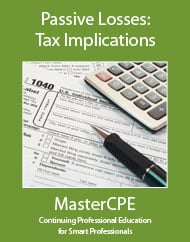Course Information
Passive Losses – Tax Implications
Course Information
| Title: | Passive Losses – Tax Implications |
|---|---|
| Category: | Taxation |
| Field of Study: | Taxes |
| Course Code: | M245 |
| CPE Credits: | 9.0 |
| Price: | 67.95 |
Description
Description:
This course addresses the practical aspects of Section 469 and the needed skill to handle pragmatic issues. Fundamentals are reviewed, planning opportunities identified, creative strategies discussed and evaluated along with remaining traditional approaches. The goal of this instructive program is to understand and solve problems under Section 469, with emphasis on tax savings ideas. Readers will overview the proper administration of this complex and often cumbersome provision.
Delivery Method: Online Interactive Self Study
Level: Overview
Prerequisites: None
Advanced Preparation: None
Course Details
Category: Taxation
Field of Study: Taxes
Passing Score: 70%
Technical Details: Taxation is a technical field of study for all states.
For More Detail:
If you are unable to view PDF then right click the mouse and click save link as
Objectives
Objectives:
Chapter 1: Overview 1. Recognize the broad impact of the Section 469 limitation provision by: a. Recalling the differences between prior law loss treatment and the former and current treatment of losses; b. Citing the prior tax shelter problem and Congress’s motives and rationales in passing Section 469; c. Specifying economic decision-making changes caused by the limitation; d. Identifying income and loss into categories; and e. Recognizing the concept of investor participation as central in determining the allowance of a passive loss. 2. Specify the mechanics of the passive loss rules, recognize the impact of Section 469 to appropriate deductions, identify what type of income may be offset by passive losses and then, determine a passive loss. 3. Identify passive losses under Section 469 by: a. Citing the “bucket” analogy of Section 469 to: (i) specify the categories of a client’s annual income and the Section 469 limitation’s impact, and (ii) determine “passive items” and “material participation” under Sect
For More Objectives:
If you are unable to view PDF then right click the mouse and click save link as
Profession
NASBA: Yes
QAS: Yes
CPA: Suitable for all CPAs
IRS: IRS credit for Enrolled Agents.
Profession Identifiers: CPA, EA

